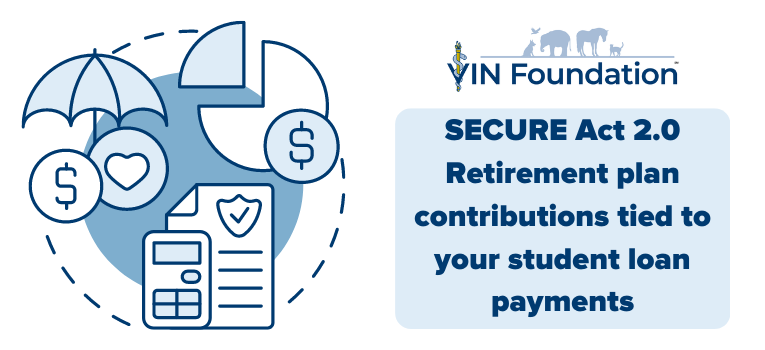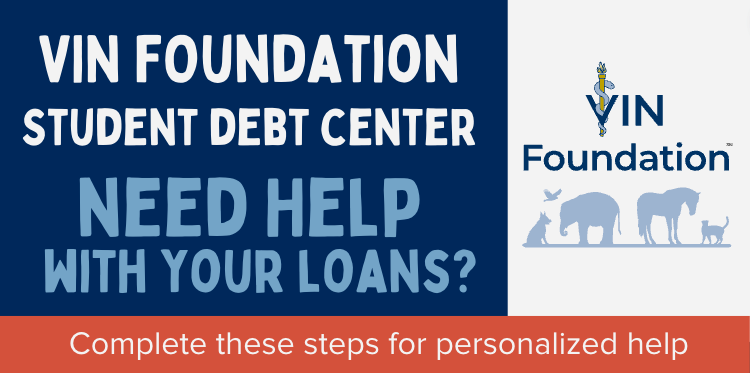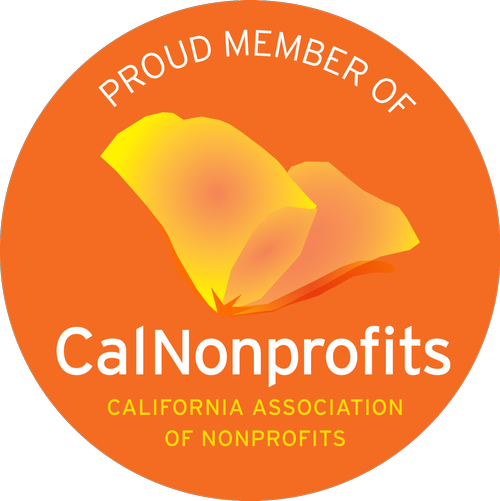Does matching student loan payments for retirement contributions make sense for veterinarians?
How SECURE 2.0 changes employer retirement savings plans
Recently, Congress passed and the President signed into law the SECURE 2.0 Act of 2022. There are many updates and changes to tax-advantaged savings options in this legislation that are taking effect in 2023 and beyond.
Making the national news rounds lately is a specific provision that allows for matching contributions to your retirement plan based on your student loan payments. Specifically, Section 110 allows employers to use your qualifying student loan payment to match their contributions to your 401(k), 403(b), or SIMPLE IRA retirement plan, starting in 2024.
There are several considerations in evaluating this new option:
- Does your employer offer this new option? Not only do they need to offer a matching retirement plan contribution, but they also need to specifically offer a matching contribution based on your student loan payments.
- Does your matching option allow you to earn more employer contribution for your student loan payments or is it at the expense of your personal contributions?
- What does it take for you to receive the maximum employer contribution to your retirement plan?
- What is your minimum monthly student loan payment?
- Does your budget allow for your monthly student loan payment AND your own retirement plan contribution?
No matter when your employer offers a matching incentive for your retirement plan, you must find a way to contribute at least what is required to receive that maximum employer contribution. This is one of the only sources of FREE (or nearly free depending on how you allocate your contributions) money that I am aware of.
Consider it personal financial malpractice to leave any of your employer’s retirement plan match money on the table. Many veterinarians are not contributing to available retirement plans for any number of reasons, and their student loans are often one of them.
Let’s use an example to demonstrate how this usually works:
- Gross Annual Income: $130,000
- Federal Student Debt balance: $185,000 at 5.5%
- Employer matches up to 3% of your retirement plan contributions
You have at least $3,900 (3% of $130,000) per year on the table that can grow tax-free, long-term for your retirement savings as long as you do whatever is necessary to receive the maximum annual employer contribution.
Before the new SECURE 2.0 provision, the example associate would need to contribute at least 3% of their income into that retirement plan to receive the maximum matching employer contribution. Following the example, the associate must contribute $3,900/year of their gross income to receive an additional $3,900/year matching contribution from their employer for a total of at least $7,800/year into their employer-sponsored tax-advantaged retirement account.
However, under Section 110 of SECURE 2.0, if eligible, you can forgo your retirement plan contribution and instead have your monthly student loan payments count towards the employer match. Next, answer the following questions:
- Is your minimum monthly student loan payment high enough to reach your full employer match? From the example, the minimum monthly student loan payment needs to be at least $325/mo ($3,900/yr). Many folks who are using an income-driven plan, particularly in the first few years after graduation may have a minimum payment lower than that. If you do, then you could still be leaving free money on the table under this new provision. Worse yet, you could be tempted to pay more than your student loan minimum payment to boost your matching contribution, potentially wasting your money instead of making personal retirement plan contributions.
- Does it make sense for you to decrease your retirement plan savings by half (at least)? Instead of contributing $7,800/year in the example (your contribution plus your employer’s match), you’re receiving only $3,900/year from your employer. This begs the next question:
- Is it more important to contribute to your retirement plan or to your student loans? You should be doing both, but maxing out your retirement plan is more important than paying above your minimum monthly student loan payment. Your retirement savings account(s) are tax-advantaged and will experience compound, tax-free growth over time. The same is not true of your student loans. A dollar contributed to your retirement savings is not equal to a dollar paid to your student loans.
Expert Tip
Paying extra while receiving the SAVE unpaid interest subsidy can waste 100% of your extra payment. Pay only the minimum due while using SAVE when your payment due is less than your monthly interest accrual. You can see your minimum payment due and monthly interest accrual in your VIN Foundation My Student Loans summary.
Financial Damage Control
In my opinion, the SECURE 2.0 student loan matching benefit falls into a financial damage control option. If you have to tighten your budget to the point where you’re cutting your retirement plan contributions below the required level to receive a matching contribution from your employer and you can still get a match based on your student loan payments, then great! It’s better to get some match and some amount contributed to your retirement plan regularly than nothing. There should be very few things that push your personal retirement plan contributions off your budget. When/if that happens, do your best to make it as temporary as possible.
Expert Tip
All veterinarians working for an employer who offers a matching retirement contribution should try to at least contribute enough to their retirement account to receive the maximum employer match while satisfying their minimum student loan payment each month.
Going beyond the minimum retirement plan contributions
Target 10-15% of your gross income into tax-advantaged retirement plans. That target exceeds any employer match that I’ve ever seen for a veterinarian. So think of the employer matching formula as the least you can do to build your long-term retirement savings. You can (and should) do better. Your current and future financial wellness will thank you.
Time is critical for retirement savings. The more (and sooner) you contribute, the longer your savings can grow tax-free, and the more you’ll have later in life. Veterinarians are already a decade or so late to the retirement savings game. You really can’t afford to wait to build your retirement savings.
Aim for the IRS-allowed maximum contribution levels in a retirement plan. For example, in 2024, you can contribute $23,000 to your 401k. The maximum level does not include your employer contribution.

Source: https://www.irs.gov/newsroom/401k-limit-increases-to-23000-for-2024-ira-limit-rises-to-7000#
If your student loans are getting in the way of meeting your employer match or that 10-15% yearly retirement savings target, revisit your budget and loan repayment options. If you need help, post on the VIN & VIN Foundation Student Debt Message Board area.
The sooner you start your long-term retirement savings, the longer they have to grow (compound tax-free growth is enormously powerful). With your federal student loan minimum monthly payment pegged to your taxable income using an income-driven repayment plan, then you should be able to start your long-term, tax-advantaged retirement savings earlier, and more than meet your employer matching incentive amount when you’re eligible to contribute.
Hopefully, the new SECURE 2.0 Act student loan payment matching provision does not incentivize people to forgo their own retirement contributions or to make payments above what their income requires for their student loans. Financially, that would be a bad move. Student loan payments and retirement contributions are not equal — a dollar of student loan payment is not the same as a dollar of retirement savings. The dollar of retirement savings is worth much more in the short and long term.
Depending on how your retirement plan contributions are structured, contributing more to your tax-advantaged retirement plans can lower your taxes AND lower your monthly student loan payment.
Returning to the example, for a veterinarian with $130,000 of gross income and a 3% employer-matching retirement contribution, contributing $20k (15% of her gross income) on a pre-tax basis would lower her annual federal income taxes by $4,800 (24% tax rate) and her minimum monthly student loan payment by $2,000 per year using the SAVE income-driven plan for a single person. That’s a $6,800 short-term savings impact and pays for a chunk of her retirement contributions.
Including her employer match, she would have contributed $23,900 (Her $20k + the $3,900 employer match) into her tax-advantaged retirement plan.
Compounding $23,900 over 30 years at 7% per year yields $182k — and that’s just one year of retirement savings. Repeat that same contribution each year you can see why focusing more on your retirement contributions vs. paying more than you need to for your student loans is a much better investment.
Spoiler alert — if you contribute $23,900 to your retirement account for 30 years, you’d have $2.4 million at the end of that 30 years — not a bad retirement nest egg. And, your student loans will be gone before then. With income-driven plans, you will be in repayment for no more than 25 years, likely 20 years (or less).
While there could be a use case here and there (e.g. temporary financial damage control scenario) where this Secure 2.0 provision can be beneficial, I don’t see a lot of value for most veterinarians. But I could also be missing something…You all can tell me 🙂
If you need student debt help, reach out to VIN and VIN Foundation. We have free online tools like the VIN Foundation Student Debt Center and special message board areas to help you make sense of your options. If you have questions on any of the available tools and options, reach out to [email protected].

Dr. Tony Bartels graduated in 2012 from the Colorado State University combined MBA/DVM program and is an employee of the Veterinary Information Network (VIN) and a VIN Foundation Board member. He and his wife have more than $400,000 in veterinary-school debt that they manage using federal income-driven repayment plans. By necessity (and now obsession), his professional activities include researching and speaking on veterinary-student debt, providing guidance to colleagues on loan-repayment strategies and contributing to VIN Foundation initiatives.


